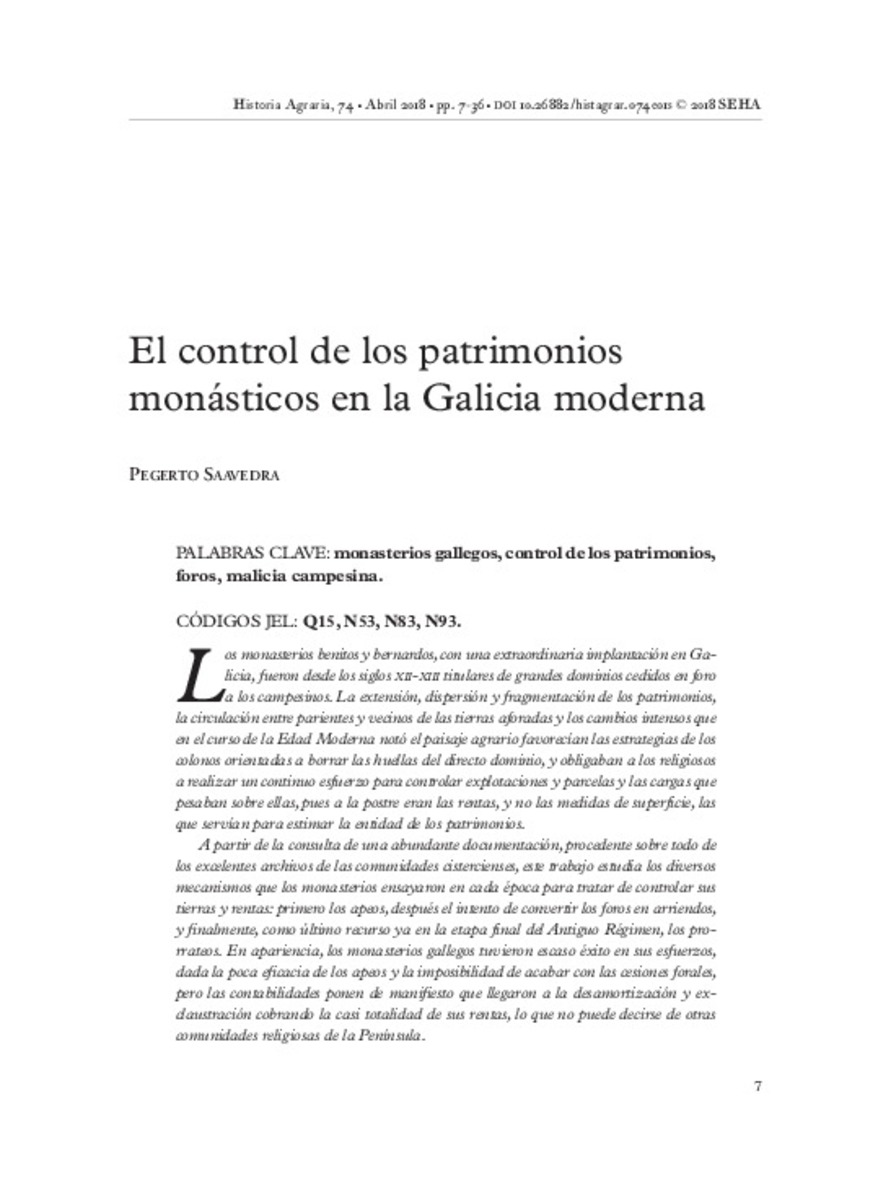Mostrar el registro sencillo del ítem
El control de los patrimonios monásticos en la Galicia moderna
| dc.contributor.author | Saavedra, Pegerto | |
| dc.date.accessioned | 2018-03-04T19:21:15Z | |
| dc.date.available | 2018-03-04T19:21:15Z | |
| dc.date.issued | 2018-04 | |
| dc.identifier.issn | 1139-1472 | |
| dc.identifier.uri | http://hdl.handle.net/10234/173194 | |
| dc.description.abstract | Los monasterios benitos y bernardos, con una extraordinaria implantación en Galicia, fueron desde los siglos xii-xiii titulares de grandes dominios cedidos en foro a los campesinos. La extensión, dispersión y fragmentación de los patrimonios, la circulación entre parientes y vecinos de las tierras aforadas y los cambios intensos que en el curso de la Edad Moderna notó el paisaje agrario favorecían las estrategias de los colonos orientadas a borrar las huellas del directo dominio, y obligaban a los religiosos a realizar un continuo esfuerzo para controlar explotaciones y parcelas y las cargas que pesaban sobre ellas, pues a la postre eran las rentas, y no las medidas de superficie, las que servían para estimar la entidad de los patrimonios. A partir de la consulta de una abundante documentación, procedente sobre todo de los excelentes archivos de las comunidades cistercienses, este trabajo estudia los diversos mecanismos que los monasterios ensayaron en cada época para tratar de controlar sus tierras y rentas: primero los apeos, después el intento de convertir los foros en arriendos, y finalmente, como último recurso ya en la etapa final del Antiguo Régimen, los prorrateos. En apariencia, los monasterios gallegos tuvieron escaso éxito en sus esfuerzos, dada la poca eficacia de los apeos y la imposibilidad de acabar con las cesiones forales, pero las contabilidades ponen de manifiesto que llegaron a la desamortización y exclaustración cobrando la casi totalidad de sus rentas, lo que no puede decirse de otras comunidades religiosas de la Península. | ca_CA |
| dc.description.abstract | From the twelfth century on significant numbers of Benedictine and Bernardian monasteries in the region of Galicia owned great dominions that were ceded under foral arrangements to peasants. These land colonizers implemented strategies of undermining direct dominion thanks to the fragmentation, dispersion and extension of the land, along with the fact that the right to cultivate land could pass to relatives or neighbours. Moreover, the intense changes affecting the agricultural land structure in the Modern Age forced the religious orders to continually seek to control these farm lands and to clarify the obligations of the tenants. Ultimately it was not the amount of land or the surface measurements that mattered for estimating the properties, but rather the land production or rents. Mainly using the abundant documentation in the splendid Cistercian archives, this paper examines the various mechanisms that the monasteries employed in each period to seek to control their lands and rents. First were the attempts to define the delimitation of the lands (apeos). Next came efforts to transform foral land tenancy into leased land arrangements. Finally, in the last part of the Ancien Regime, prorating was used. Given the rather inefficient outcome of the delimitation of land and the failed attempts to end the foral arrangements, a cursory reading would suggest that the Galician monasteries were not very successful in their efforts. Yet their accounting indicates that they actually managed to collect almost the entire amount of their rents at the time of the disentailment and exclaustration of church lands, which is more than can be said of other religious communities throughout the Iberian Peninsula. | ca_CA |
| dc.format.extent | 29 p. | ca_CA |
| dc.format.mimetype | application/pdf | ca_CA |
| dc.language.iso | spa | ca_CA |
| dc.publisher | Sociedad Española de Historia Agraria (SEHA) | ca_CA |
| dc.relation.isPartOf | Historia agraria: Revista de agricultura e historia rural, nº 74, 7-36 | ca_CA |
| dc.rights | © 2018 SEHA | ca_CA |
| dc.rights | Attribution-NonCommercial-NoDerivatives 4.0 Internacional | * |
| dc.rights.uri | http://creativecommons.org/licenses/by-nc-nd/4.0/ | * |
| dc.subject | monsaterios gallegos | ca_CA |
| dc.subject | control de los patrimonios | ca_CA |
| dc.subject | foros | ca_CA |
| dc.subject | malicia campesina | ca_CA |
| dc.subject | galician monasteries | ca_CA |
| dc.subject | control of lands | ca_CA |
| dc.subject | peasant resistance | ca_CA |
| dc.title | El control de los patrimonios monásticos en la Galicia moderna | ca_CA |
| dc.type | info:eu-repo/semantics/article | ca_CA |
| dc.subject.jel | Q15 | ca_CA |
| dc.subject.jel | N53 | ca_CA |
| dc.subject.jel | N83 | ca_CA |
| dc.subject.jel | N93 | ca_CA |
| dc.identifier.doi | http://dx.doi.org/10.26882/histagrar.074e01s | |
| dc.rights.accessRights | info:eu-repo/semantics/openAccess | ca_CA |
| dc.relation.publisherVersion | http://www.historiaagraria.com/numero.php?n=74 | ca_CA |








